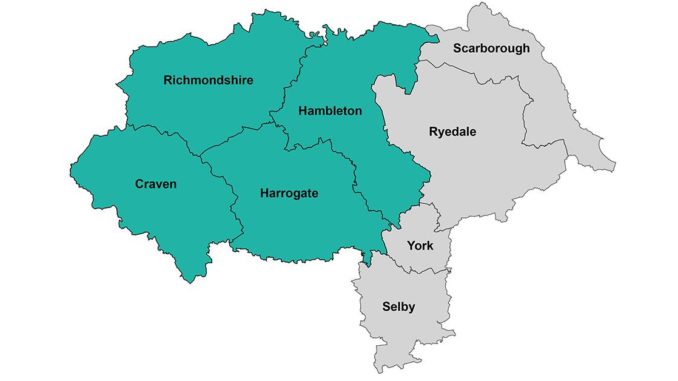
Consultants say an ‘East & West’ model of two unitary councils in North Yorkshire is the best way to reorganise local government,
KPMG was commissioned by the county’s district and borough councils to analyse the different options for local government reform in the county.
Councils have been invited to submit an outline bid to Government by November 9, proposing how unitary authorities could be created within North Yorkshire and York.
The district and borough councils, which have proposed the East/West split model, hired KPMG to assess the options and propose a model for local government reform based on research and evidence.
The council says this research provides “compelling evidence” that the creation of two unitary authorities of balanced size would provide the strongest local leadership, the most effective services and the fairest democratic representation, as well as the most savings for local taxpayers.
The East/West model would see Craven, Harrogate, Richmondshire and Hambleton join together to form a unitary council in the West, and Selby, City of York, Ryedale and Scarborough join together to form a unitary council in the East.
According to the study, this model would produce two unitary authorities with a similar population and economic size, that meet the government’s reform criteria.
The unitaries would provide the strongest approach to unlocking devolution – potentially worth billions to the region in investment – whilst also being the optimum size for effective strategic and local service delivery to citizens and communities.
The contents of the study have been shared with councillors this week, and are being published on district and borough council websites on October 23.
All seven district and borough councils will then consider the study at democratic meetings in early November before the government’s deadline for proposals.
If one or more council agrees to submit the KPMG research study, it will form part of the outline bid to Government in November.
North Yorkshire County Council is expected to put forward a bid for what the district authorities have dubbed a ‘mega-council’ model, which would see a unitary authority covering the whole of North Yorkshire, with a population of 618,000 while preserving the existing City of York unitary authority with a population of 211,000.
District chiefs say this is contrary to the Government’s criteria, which sets the optimal population range for a unitary council at between 300,000 and 600,000 people.
Councillor Richard Cooper, leader of Harrogate Borough Council, speaking on behalf of the leaders, said: “This research by KPMG shows clearly that the East & West model of local government reorganisation is better than any of the alternatives.
“The KPMG study clearly shows that the East and West model will provide strong local leadership, the most effective services, the fairest democratic representation, the most financial savings. Our model, with two equal partners, also provides the strongest approach to unlocking devolution.
“We expect North Yorkshire County Council to submit a proposal for a ‘mega-council’, which would create a massive imbalance. North Yorkshire is five and a half times the size of Greater London; it’s as big as Bedfordshire, Berkshire, Buckinghamshire, Hertfordshire and Oxfordshire combined.
“We continue to consult with local people, businesses and partners as we finalise our case for an East and West model.”
The district and borough council leaders are: Cllr Richard Foster (Craven), Cllr Mark Robson (Hambleton), Cllr Richard Cooper (Harrogate), Cllr Angie Dale (Richmondshire), Cllr Keane Duncan (Ryedale), Cllr Steve Siddons (Scarborough) and Cllr Mark Crane (Selby).


Be the first to comment